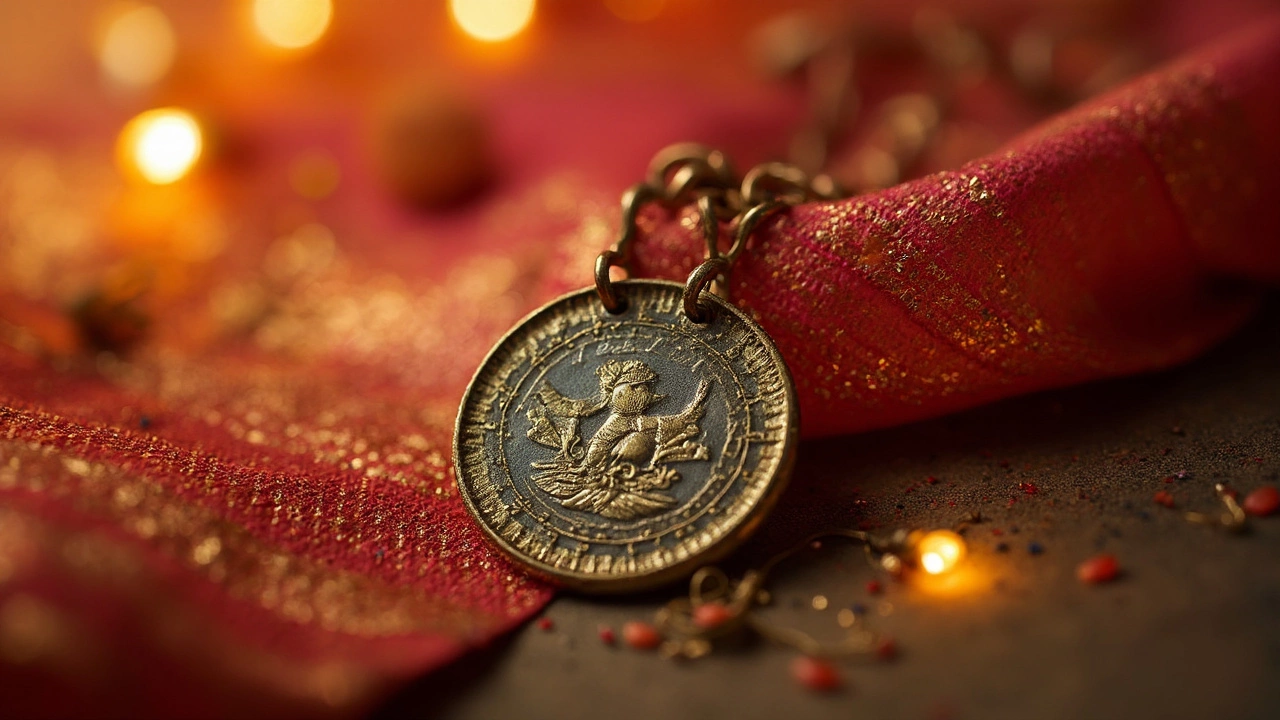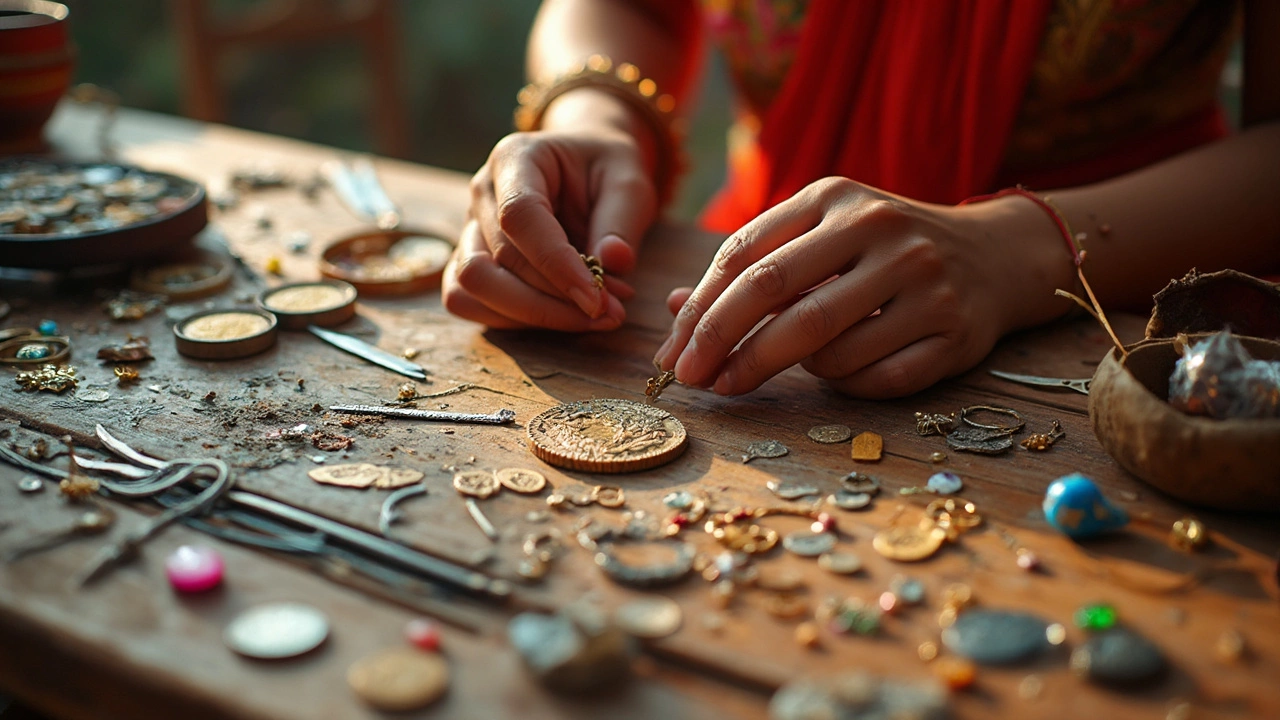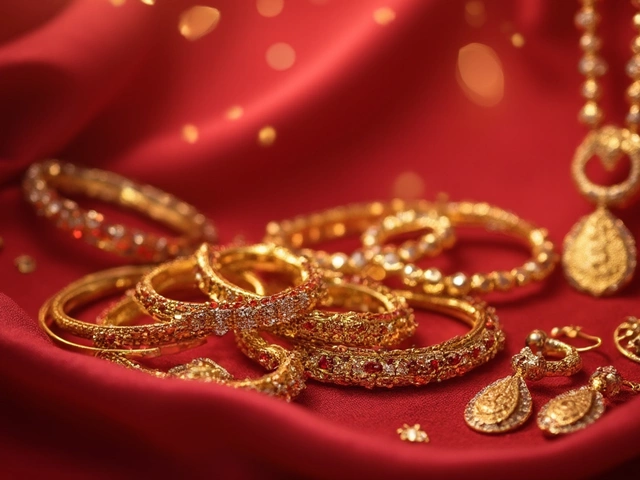People often run into a serious dilemma when wanting to wear a coin as a necklace: drilling a hole can ruin its look or destroy its value. But here’s the good news—you don’t have to go near a drill at all. There are some clever jewellery-making solutions that let you keep your coin totally intact. No holes, no mess, and no regrets.
All you need are a few tools from any jewellery making kit (or even from a craft store online), plus a couple of things you probably already have at home. Whether you’re working with an old lucky penny, a travel souvenir, or something more precious, these methods keep the coin safe and reversible.
One trick that many people use is a pendant holder (sometimes called a coin bezel). It acts like a tiny frame that grips the coin securely. You can easily pop the coin in or out whenever you want, no glue or sticky mess required. Wire wrapping is another solid go-to—it not only protects your coin, but you can turn even a plain coin into a one-of-a-kind statement piece.
- Why Avoid Making a Hole?
- Choosing Your Coin and Style
- Best No-Hole Pendant Holders
- Wire Wrapping Techniques
- Using Coin Bezels and Cases
- Finishing Touches and Tips
Why Avoid Making a Hole?
Punching a hole through a coin is pretty final—once it’s done, there’s no undoing it. For a lot of people, that’s a dealbreaker, especially if the coin is old, rare, or has sentimental value. Apps like Coinoscope and even basic googling can show you that some coins are worth a lot more than you’d think. Even small marks or scratches can slash a collectable’s value in half.
But it’s not just about money. Maybe you got the coin from a grandparent or brought it home from a dream vacation; that piece tells a personal story. Putting a hole in it kind of rips out some history. Collectors have a term for it—coins that have holes, notches, or are bent are called “damaged,” and dealers will almost always pass on buying them or pay way less.
Plus, there’s the look factor. A visible hole can be distracting, especially with a cool design or text. If you ever decide to swap the coin back into your collection or pass it on as a keepsake, you don't want a random hole there ruining the vibe.
For these reasons, a coin necklace made without drilling has become way more popular. With today’s jewellery making kits and supplies, you have way more choices for showing off your coin—and keeping it 100% intact.
Choosing Your Coin and Style
Picking the right coin for your necklace takes a bit more thought than just grabbing whatever is lying around. Some coins have sentimental value, while others grab attention because of their design or shine. The first thing to think about is what the coin represents to you—maybe a lucky penny, a foreign coin from a dream trip, or even an old silver dollar with cool vintage vibes.
If you’re eyeing collectible or rare coins, keep in mind that anything you do should never lower its value. Certain coins can be worth hundreds or even thousands if they’re kept in perfect shape. Here’s a quick look at some coin types and how they usually hold up:
| Coin Type | Durability | Collectible Value |
|---|---|---|
| Modern pennies | Medium | Low to medium |
| Silver dollars | High | High |
| Euro coins | High | Low to medium |
| Old foreign coins | Varies | Varies |
Now, let’s talk style. A coin necklace can be as simple or as bold as you like. If you like to keep things subtle, go for a single coin with a clean holder. For more flair, you could layer coins, mix metals, or add beads. But, let the coin stand out—don’t overload it with extras.
- Match the coin size with your neck chain—big coins on dainty chains often look off.
- Gold coins go well with warm-toned chains, while silver coins pop on cooler metals like stainless steel.
- If you want the coin to spin or flip, pick open settings; for more security, go for closed bezels.
Before you buy or use any coin, always check the edges. Some coins are thicker, so double-check the holder fits snug but not too tight. Size matters when it comes to bezels and cases, so a digital caliper or even a ruler makes your life way easier.
Best No-Hole Pendant Holders
If you want to keep your coin scratch-free and valuable, your best bet is to use a pendant holder made just for coins. The most popular types are coin bezels, coin capsules with loops, and adjustable claw settings. They grab onto your coin without doing any damage—no glue, no holes, and no risk to your keepsake.
The coin bezel is hands-down the easiest and cleanest way. Think of it as a tiny metal frame that snaps tight around your coin. Most bezels come in common coin sizes. You just open it, drop your coin in, and close it up—done. No tools necessary, and you can pop the coin back out any time. For classic looks, many people go with sterling silver or gold-plated bezels. On top of that, modern snap-tite bezels make installation super simple, even if you're a total beginner.
Another solid option: coin capsules with loops. These are clear, hard plastic cases that protect both sides of your coin while still letting you show it off. They come with a built-in loop for stringing onto a chain. This is a go-to for anyone who wants extra protection for valuable or old coins. They're cheap, widely available, and practical. Just double check the coin's diameter before buying—the fit needs to be snug so the coin stays put.
If your coin isn't a standard size, adjustable claw settings are useful. Small metal prongs grip the edge of the coin. You tighten them just enough to hold it safely. Look for settings that let you bend the prongs gently by hand or with simple pliers from your jewellery making kit.
- Coin necklace holders should always let you remove your coin later. Test the fit before wearing out.
- Always check that your holder is metal-safe—avoid cheap metals that might scratch or react with your coin.
- For a really tight, professional look, measure your coin with calipers before ordering a bezel or capsule.
These holders beat glue, tape, or wire hacks if you want maximum security with zero coin damage.

Wire Wrapping Techniques
Wire wrapping is one of the neatest ways to turn a coin into a necklace—no hole, no glue, just a bit of wire and some simple tools. This isn’t just a hack for beginners. Even pro jewellery makers use wire wrapping for precious or collectible coins they don’t want to damage.
Here’s how you can get started:
- Pick a wire that’s strong but flexible. Copper, silver-plated, or craft wire work well. Aim for 20- to 22-gauge wire, which is sturdy enough to hold even heavier coins but not so stiff you can’t manipulate it by hand.
- Cut a piece of wire about 40-50 cm long (it’s better to have extra than to run out in the middle).
- Hold the coin flat and center it near one end of the wire. Loop the wire around the coin’s edge, making sure to keep it tight but not so tight that the wire bites into the coin.
- After the first loop, wrap the remaining wire around both the edge and itself, making a “cage” that hugs the coin. At the top, twist the remaining wire a few times to secure everything together.
- Create a small bail—the loop where your chain will go—by twisting the end of the wire into a circle or using round-nose pliers if you’ve got them. Tuck in any sharp points to keep things wearable and snag-free.
This method means you never need to drill or glue anything. The best part? If you mess up, you can just unwrap and try again with a fresh piece of wire.
For more advanced looks, try weaving in a second color of wire or adding tiny beads. There are tutorials online that walk you through every style—just search for “coin necklace wire wrapping” and the ideas are endless.
If you want your coin to be really secure, give the coin a little shake after you finish wrapping. If it rattles, add an extra loop or two around it, or squeeze your wire cage a bit tighter. The end result is a personalized pendant that looks great and leaves your coin totally untouched.
Using Coin Bezels and Cases
Coin bezels are the real game-changer if you want to make a coin necklace without damaging your coin. A bezel is basically a metal frame that snaps or screws around the coin. You don’t need any glue, solder, or risky moves that could leave a scratch. These are actually the method most professional jewellers use for collectible or valuable coins.
Bezels come in several sizes and metals—usually sterling silver, gold-filled, or stainless steel. You just find the correct diameter for your coin and pick the finish that matches your style. When shopping online, you’ll see most bezels list measurements in millimeters (mm), so it helps to check your coin’s diameter with a ruler first.
Here's how easy the process can be:
- Measure the coin’s diameter using a ruler or caliper.
- Order a bezel that matches (sometimes labelled by coin type, like "US Quarter bezel").
- Open the bezel—some twist open, others have a tiny screw.
- Place the coin inside and close it.
- Attach the loop or bail at the top to your chain, cord, or leather thong.
Coin display cases are another no-damage trick, especially for very rare coins. These are clear acrylic or plastic holders that snap together. A lot of collectors use them for storage, but you can actually find cases with pre-made holes for attaching to necklaces or key rings. Acrylic cases protect against scratches, fingerprints, and daily dirt, which matters if you’re wearing a collector’s item.
People tend to ask: do bezels really keep coins secure? Absolutely. Most modern bezels have a locking mechanism or screw that grips tight, so there’s no chance of the coin slipping out. Check out this quick table that compares popular bezel materials for coin necklaces:
| Material | Looks | Best For |
|---|---|---|
| Sterling Silver | Shiny, classic | Vintage or elegant coins |
| Gold-Filled | Rich, yellow tone | Gold coins, keepsakes |
| Stainless Steel | Modern, tough | Everyday wear, lower cost |
One tip: always double-check that the loop (bail) at the top of the bezel fits your chosen chain. Cheap bezels sometimes come with tiny bails that only work with thin chains, so switch it out if you want something chunkier. And don’t forget, both bezels and cases can be found at craft stores, online jewellery suppliers, or even coin shops. It’s easier than most people think—and honestly, it beats punching a hole in your coin any day.
Finishing Touches and Tips
You’re almost ready to rock your new coin necklace, but these last steps make all the difference between a piece that lasts and one that falls apart or tarnishes right away.
First, check all your joins, whether you used a bezel, wire wrapping, or a snap-in holder. Give them a little tug—not too hard, just enough to make sure nothing’s going to slip or open up with daily wear. Add a small dab of clear jewelry glue to wire ends if you’re worried about sharp tips poking out, but only as a last resort if you can't get a smooth finish.
Now, let’s talk about chains. Go for a chain that matches the coin’s style and weight. A delicate coin calls for a light chain, while a chunky or heavy coin needs a thicker, sturdier option. Stainless steel, sterling silver, and gold-plated chains are the top picks since they last and don’t tarnish easily compared to cheaper options. Here’s a quick look at chain materials and durability:
| Chain Material | Durability | Ideal For |
|---|---|---|
| Stainless Steel | Very High | Daily Wear, Budget Friendly |
| Sterling Silver | High | Allergy Friendly, Classic Looks |
| Gold-Plated | Medium | Special Occasions, Stylish |
| Nickel | Low | Temporary Use, Costume Jewelry |
One big tip—keep the coin away from water and lotions if you want it to stay looking sharp. Some coins, especially older or copper ones, will tarnish fast if they get wet regularly. Store the necklace in a dry box lined with a soft cloth and, if you want extra protection, seal the coin side that faces your skin with a clear skin-safe sealant. This not only helps prevent tarnishing but also protects the coin’s design.
If you’re giving your necklace as a gift, add a quick polish with a jewelry cloth. Finish it off with a sturdy clasp—lobster clasps are more secure than spring rings. Don’t forget the most basic tip: always put delicate jewelry on last, after dressing and applying perfume or beard oil, so nothing gets snagged or stained.
With a few minutes of cleanup and prep, your coin necklace won’t just look good today. It’ll hold up for months of real life, whether you’re heading to work or out for a late-night run for ice cream.



